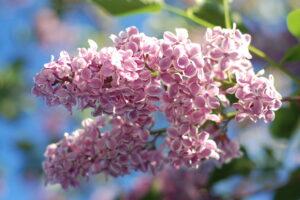Revised August 15, 2025
Dying leaves on the lilacs is showing up again this summer. Below is an article from 2024 explaining it all.
From MPR in 2024: Confused Minnesota lilacs are blooming a second time.
One cannot help but notice the naked branches of lilac bushes in nearly every yard around. SCA has located information below which is cited directly from Fungal Leaf Diseases of Lilac, by the University of Minnesota Extension. See the full article here. There is hope for next year!
“Leaf diseases like Septoria and powdery mildew can cause concern as people watch the leaves of otherwise healthy lilacs (and sometimes other shrubs) turn yellow, then brown, and then drop to the ground.
Cool temperatures and wet, windy conditions spread fungal spores that cause diseases and negatively affect plants. When conditions are dry, the chances of fungal leaf diseases to emerge are reduced.
The fungal disease Septoria leaf blight (also referred to as Pseudocercospora leaf blight) has existed in Minnesota landscapes for some time. During dry growing seasons, it is less noticeable until around mid-August or early September. Wet conditions in spring and early summer can cause fungal leaf diseases to emerge earlier.
Septoria is specific to the leaves and fortunately, is more of an aesthetic issue than a severe health problem for plants. However early disease emergence followed by leaf loss reduces photosynthesis and the ability of plants to generate energy. This can increase plant stress and reduce plant health.
Symptoms of fungal leaf diseases
- Spots, blotches and dead areas on leaves.
- Leaves turn yellow, then brown, and then drop.
- Branch dieback is random, on one shrub in the middle of a hedge, all one side of a hedge, or on individual branches.”– Courtesy of University of Minnesota Extension
Was this post useful?
Average rating 4.8 / 5. Vote count: 4
No votes so far! Be the first to rate this post.












